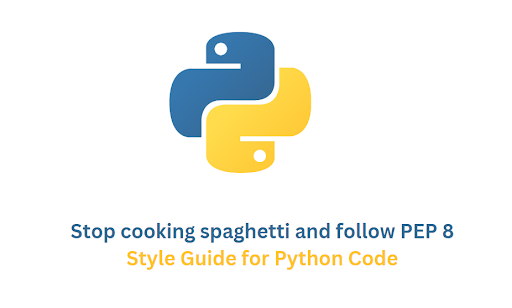Stop cooking spaghetti and follow PEP 8 – Style Guide for Python Code

Spaghetti is one of my favourite dishes out there, but I don't know how to cook it. Fortunately, I do know how to cook spaghetti in coding, and today, we will cover how not to do it using the PEP 8 style guide for Python code.
Many developers fall into the trap of writing "spaghetti code"—a tangled mess that is hard to read, debug, and maintain. We developers are fortunate to have PEP 8 to help them maintain consistency and readability in their projects, not just for Python but for other programming languages as well that have these kinds of style guide libraries we can use.
For instance, using vague variable names like ‘x’ or ‘data’ makes code hard to understand. Deep nesting, such as multiple ‘if’ statements inside loops, complicates readability. Improper whitespace and indentation can cause confusion and errors when collaborating as well. These practices lead to difficult debugging, limited scalability, and higher maintenance costs. By following PEP 8, Python developers can create readable, maintainable code that facilitates collaboration and reduces errors in long-term projects.
Problems with Spaghetti Code
Spaghetti code is a poorly structured and tangled codebase that is difficult to read, maintain, and debug. It is caused by inconsistent indentation and formatting, which makes it challenging to follow the flow of the program. Additionally, it often features hard-to-read variable names, further reducing code clarity. The lack of comments causes problems, leaving developers without guidance on the code's intent or functionality. Finally, spaghetti code frequently contains overly complex logic, making it prone to errors and time-consuming to modify or extend.
Why Follow PEP 8?
- Readability: Consistent code is easier to read and understand, especially in team settings.
- Maintainability: Clean code is simpler to review and debug.
- Collaboration: Teams benefit from consistent style, making onboarding and collaboration smoother.
- Professionalism: Adhering to PEP 8 signals to peers and employers that you value clean, professional code.
Tools for Automating PEP 8
There are various tools introduced that take care of the PEP 8 style guide without you taking care of it each time. Some of them are:
- Flake8: Lints Python code for PEP 8 violations.
- Black: Formats code automatically to conform to PEP 8.
- PyCharm/VS Code: Integrated development environments (IDEs) with built-in PEP 8 checkers.
Common PEP 8 Guidelines
1. Indentation
PEP 8 recommends using four spaces per indentation level.
Bad Example:
Good Example:
2. Line Length
Limit all lines to a maximum of 79 characters.
Bad Example:
Good Example:
3. Blank Lines
Use blank lines to separate sections of code and enhance readability:
- Two blank lines between top-level functions or class definitions.
- One blank line between methods in a class.
Bad Example:
Good Example:
4. Imports
- Place imports at the top of the file.
- Use one import per line.
- Group imports in the following order: Standard library imports > Third-party imports > Local application/library-specific imports
Bad Example:
Good Example:
5. Comments
Write clear and concise comments and focus on the ‘why’ instead of the ‘what’.
Bad Example:
Good Example:
Conclusion
Now we know how to avoid making spaghetti in coding; all that’s left is to cook spaghetti in real life for you and me if you haven't already done so!
If your codebase still looks like a plate of spaghetti, it’s time to pick up the PEP 8 guide and clean up. It’s not just about the look; it's about code that’s professional, maintainable, and collaborative.

Member discussion